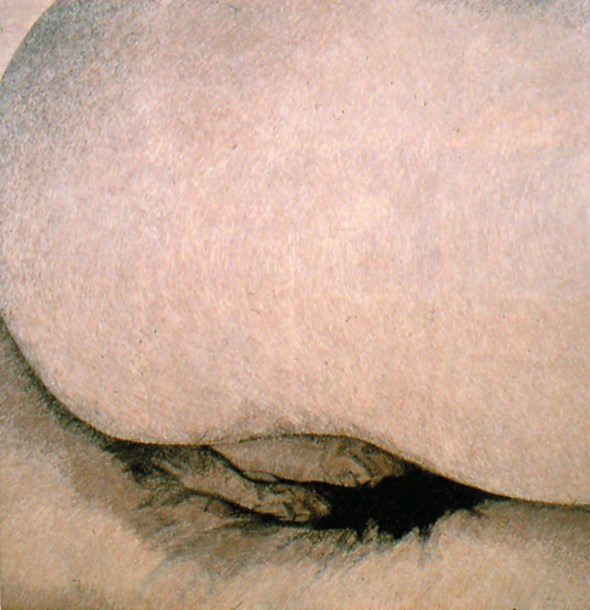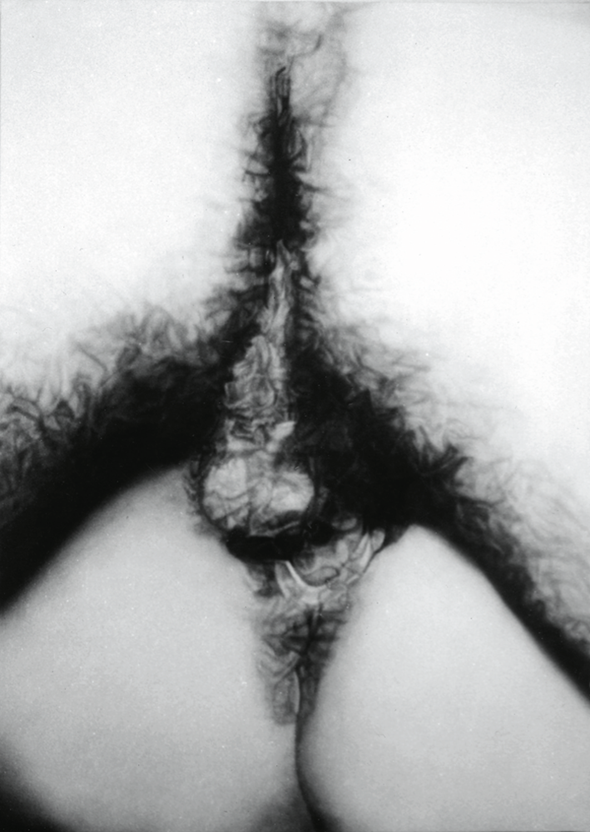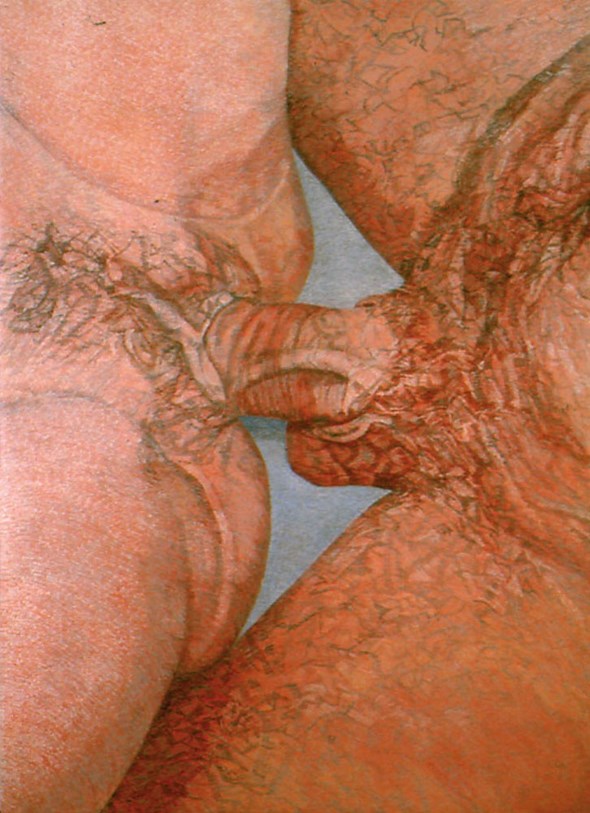
Daniel Baumann: Let’s start from where it all began, with the Fuck Paintings. Though I like the initial title Joined Forms.
Betty Tompkins: I never called them Joined Forms, I just wrote it on the back of the canvases, but I always called them Fuck Paintings. Joined Forms came about because of the time when I started them, in 1969, when everything was very minimal and conceptual, when critically it was a very heavy period.
So initially you opted for a more minimal title?
Yeah, but it didn’t work very well for me.
Can you say why you did the Fuck Paintings at the time?
I didn’t start them in reaction to the kind of art being made around me. In 1969 I had just moved to New York and I was going around to visit all the galleries and sucking up the atmosphere. I was so enthusiastic! I noticed after a while that I was going in and out of galleries really fast. Somebody would spend a long time making their show and I couldn’t even stand there a few minutes to see what they had done. One of the reasons I started to do the images was that I wanted the people to really stand there and see what I was doing as a painter. I demand a lot from my audience. For me, the image and the abstract quality are equally important. I wanted people to stand there and I figured that was a subject matter that would actually make them stand there. Does that make sense?
Absolutely! I liked Joined Forms because, yes, that’s the way you can perceive them, as forms coming together with all the possible beauty involved, although I admit that you can’t ignore the image either.
Those two things have to work, they play off each other, if the one isn’t there, the other won’t work.
Back around 1970, how did people respond to the Fuck Paintings?
Oh, not well… After I had a couple of them done, I tried to get dealers to come up to see what I was doing. At that time I was living on West 121st street and it wasn’t so easy. It was better when I moved down to Soho a year or two later. But some dealers did come and I remember one dealer coming to our very small New York apartment where the bedroom was also my studio. The living room was my (then) husband’s studio so if you didn’t want to look at art, you had to sit in the bathtub. This one dealer walked in and ran out, and then backed in, and left. Having started them in 1969, I didn’t get to show any of them until 1973 when I was in a group show at Warren Benedek Gallery in Soho. The same year, I was in a show at the Loguidice Gallery in Soho with very established people, except for me. Carl Andre was in it, my painting was hanging next to an Artschwager, Hannah Wilke was in it, so it was very very good company to be in. But nothing really happened, the shows weren’t reviewed, the paintings weren’t sold. The dealers of course didn’t want anything to do with me after that. In 1973 two paintings, Fuck Painting #1 and Fuck Painting #5 were sent to Paris for an exhibition and auction at Guy Loudmer’s, but French customs did not allow them into the country. It took me a year of legal wrangling, calling, and letter writing to get them back. Then nothing happened until 1975 when I was in a show at the Houston Museum of Modern Art which sounds really fancy but it was an artist-run place. Paul Schimmel who had been a student of mine when he was in high school and who was then a graduate student of Jim Harithas curated the show and invited me. I sent four pieces. The other day I found a review from the Houston Post of the show from December 18th, 1975, written by Mimi Crossley. The part about me says: »Four giant paintings (not photographs) by Betty Tompkins on the wall are Super-realist infinitely detailed pictures of sex organs, about as interesting as a medical textbook.« So that was all my press!
That was all your press for about six years?
That was all my press for about thirty years on these paintings! In the late 1970s, I changed from the fuck images to paintings entitled Cow/Cunt which were originally called Condensed/Dispersed. They were about relative scale, something small and delicate like a cunt and something really big and ungainly like a cow. Only one of them was ever exhibited. In 1978, one was shown at the World Trade Center in an Organization of Independent Artists exhibit. Eventually, I put all these paintings away and moved on to other ideas. In general, I would say that I am a very slow artist. At the end of the 1970s, when I decided to stop using the sexual images, I started with language based pieces. I have this idea about distance. I want my pieces to look different from close-up than from the standard of viewing distance. From far away, these images are very realistic, when you get closer they break up into language.
So the image, for instance the cow, was made out of words? Yes, and for years I just did them as tiny pencil drawings. The words were like a tenth of an inch, then I graduated to a quarter of an inch.
Would you use one or different words?
I would just use the one defining noun like bull, grass or cow. I had a show in 1983 that was very unfortunate, one of those bad dealer-experiences. It was my first solo show in New York and just a nightmare. So I stopped doing the pieces. I was a gym nut at the time, still am actually, I lifted weights and was around all these beautiful body builders, and got very involved with this kind of culture, so I did the Muzzlemen paintings. They were body builder bodies with animal heads. Doing them brought me into mythology, eventually I separated the animal from the body, the body became the statues, so I did some things based on Greek and Roman statuary which I put into fictional settings, but it just got boring to me and I stopped doing them. I went back to sex, but in a soft-core way. I used “girlie” books with pictures from around 1900-1930. I drew on the book pages and did paintings on tools, like frying pans, saw blades, axes and meat choppers. They finally brought me back to the hard core sex.
They are very different from the works of the 1970s. You stood away for a moment from where you started out.
I just never could get anywhere. Then fortunately Mitchell Algus came into my life. This is what happened: In 1994 I spoke to Chuck Close who had just been to the opening of a Whitney Biennial. He said to me: »You know, I was at the Whitney the other day and I just kept thinking about your old Fuck Paintings.« I said: »Why???« He replied: »There are these younger artists trying to do what you did, and your paintings just blow them away! Get the slides out, send them around again.« I was going: »Oh god!«, but I did send them to some really good galleries, but they basically beat me home. Nobody was interested; it was the same old story all over again. A few years after that, in 2000, I heard that Jerry Saltz, the critic for the Village Voice, was going to curate a show about sex. I sent him slides and this letter: »Dear Mr. Saltz, I understand that you are going to curate a show about sex. I hope you will consider my work. Sincerely Betty Tompkins.« I never heard from him. In 2002, I got a call from Mitchell Algus saying he wanted to see the work I did in the 1970s. I could show him some of the works of the 1970s because in 1997 I had done a small retrospective at Monmouth University entitled The Women in My Life and had put one of the Fuck Paintings and one of the Cow/Cunt paintings back on the stretchers for that show. He came in and said: »Yes, those are the paintings I saw on the slide sheets.« What happened was that Jerry Saltz had gone into Mitchell’s gallery with the slide sheets saying: »You should go look at these!« Everything you read about me is because of this time line and Jerry Saltz’s generosity and Mitchell’s support. Mitchell did a show at his gallery from which Bob Nickas curated me into the Biennale de Lyon in 2003 where Camille Morineau, a curator from the Centre Georges Pompidou saw my paintings and presented me to the acquisition committee. And they bought Fuck Painting #1! And now this show at Galerie Andrea Caratsch in Zurich. It’s like a fairy tale!
And it took a long time!
Years! Years! When I first took the Fuck Paintings out, they were really shocking to me. I had forgotten about them. I was stunned when I saw them: »God, what was I thinking?« In the process of cleaning them up and being physically in touch with them, everything that I have thought, motivated and felt originally just came floating back. This enabled me to continue in a natural flow from the old pieces to the ones that I am doing now.
They reconnect with the works of the 1970s?
Absolutely!
Is there a big difference between then and now in the way the sexual images are received?
Entirely! Now, they are getting critical receptions and reviews. I always thought that the art world was self-censoring. Ten years ago, when the senator Jessie Helms was attacking Karen Finley and Andres Serrano, I thought to myself if I hadn’t already done theFuck Paintings, I would do them today. I am glad not to have done them in response to something political, but to have done them out of my own desires. One of the things I like about this imagery is that everybody has sex one way or another, but we don’t see ourselves doing it. So we have a real curiosity about what it looks like. I think that for many people curiosity is a plus and a minus, they look and are attracted and repulsed at the same time. That is okay with me.
Right, one is a bit surprised by what one sees.
Yes, they still startle; I hadn’t thought that art can do that anymore.
I also like them the way the two forms come together, seemingly just in a normal way. I read that they were made with airbrush technique?
The original ones, yes! I used only white and black paint, so all the greys are optical mixes. There are hundreds and hundreds of layers to build up the paint. The effect with this technique is that when you go up close to the painting it goes out of focus. The new paintings that I am doing now started with using rubber stamps. They are made of the vernacular words we use to describe sex, like »fuck« or »schtupp« or »screw« or »poke,« but nothing negatively judgemental like »kinky.« Positive judgements are okay like »hot« and »sex« or »hot« and »kiss.« I’m working right now also on some paintings made just with my fingerprints, petting and caressing the image into being. It is very hands on.
Could you say something about the more recent language paintings and their relationship to the early Fuck Paintings?
The first time I used language in my pieces was after I was censored. I did a group of drawings where I censored the images that had been censored by French customs. In some of them I censored the part they censored, in others I censored everything else and drew what they had tried to take out.
How did you censor it?
The first Censored drawing I did, I wrote the word »CENSORED« in pencil. After that I had a rubber stamp made with the »Censored« word. My handwriting is ironically very bad so the stamp was better. One of the Censored drawings has only »Censored« written in every square of the grid. Very minimal. I got the idea to use words and stamps again when I was in Lyon at the Biennale in 2003 because I wanted to give Bob Nickas a drawing to thank him for his support of my work. I like that I could revisit an earlier idea and make it new again. And I like how we can use language to give a different meaning to an image.
You face a quite unique situation: you have worked for almost forty years, but there has not been much discussion about it. Nevertheless, do you consider yourself as being part of a larger movement? Do you or did you connect with certain attitudes?
Yes, I have had the weirdest career. I was a total failure at getting any movement to adopt me as one of their own, so I lost all interest in being labeled as anything. I don’t think you can escape being labelled. People just do it but it doesn’t mean anything to me. The Cow/Cunts, besides being about relative scale were also my idea of doing work that was more acceptable so you can see I have been out of sync with the way the world sees things from the start. I work from my gut, try to stay true to myself, and don’t worry about how my ideas will be received.
DANIEL BAUMANN is curator, critic and conservator at the Adolf Wölfli Foundation of the Kunstmuseum Bern. www.denver.cn
BETTY TOMPKINS, born 1945 in Washington, D.C. lives and works in New York and Mt. Pleasant, Pennsylvania
Represented by GALERIE RODOLPHE JANSSEN, Brussels; GALERIE ANDREA CARATSCH, Zurich


